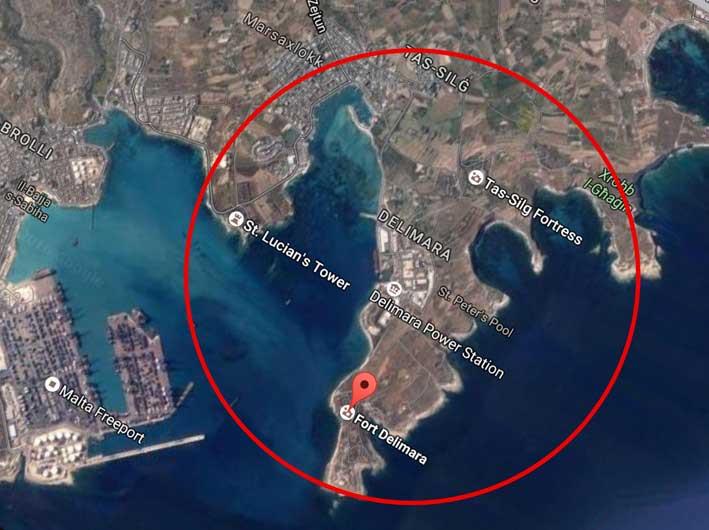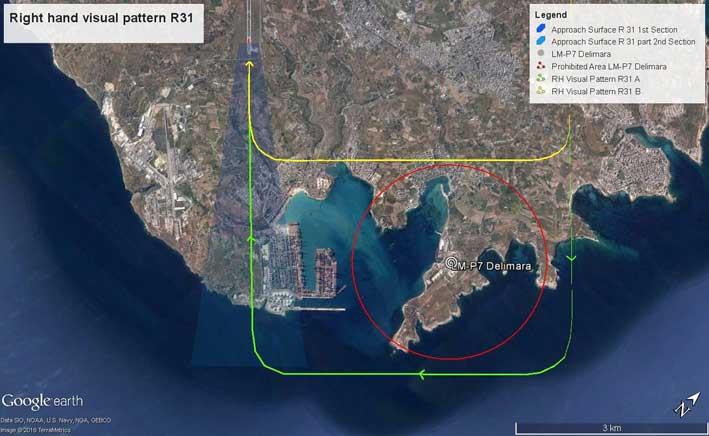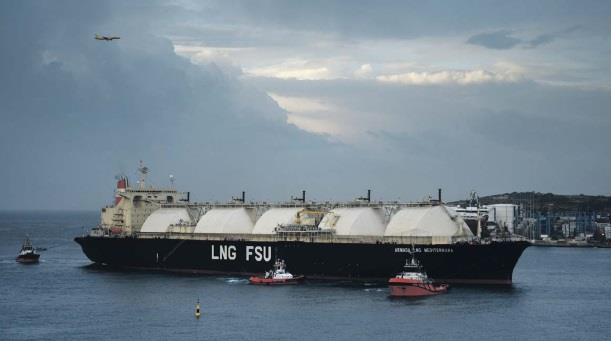Transport Malta will impose a no-fly zone with a diameter of 3 kilometres and a height of 2,000 feet around the LNG tanker and power station, The Malta Independent can reveal.
The restricted area stretches from the San Luċjan tower to Fort Delimara to Xrobb l-Ghagin, meaning that aircraft can no longer fly over the Delimara peninsula.
Sources in the aviation industry said the move could severely restrict the movement of private and commercial flights.

This newspaper has seen an email sent to pilots and flying schools by the Civil Aviation Directorate (CAD) in which it informs them that it has been instructed and tasked to establish “in the shortest time possible” Malta’s first Prohibited Area surrounding the central areas of the LNG Tanker / Delimara Power Station. “This area needs to be published in the shortest time possible,” the email says.
The CAD said it was notifying pilots now instead of letting them find out about the changes by means of a Notam (Notice to Airmen). “We thought it was only in your interest to be advised about such Prohibited Airspace at these early stages in order to plan any (if required) modifications to your Standard Operating Procedures and/or Ops Manuals.”

The directorate said “aircraft being asked to hold in Marsascala area or for those aircraft asked or wishing to perform a wide right hand visual circuit 31 might need (on the basis of aircraft class and performance) to plan ahead” using two provided routes.
The CAD asked the pilots for feedback where they “feel that the inclusion of such an area (1.5 km radius and altitude 2000 feet) will have any gross operational issues that may affect your day to day operations.”
Email correspondence sent between the CAD and TM’s Air Navigation Services & Aerodromes Unit shows that the aim of the prohibited flying area is to “protect the Delimara power plants from airborne risks.”

An aeroplane flies over the LNG tanker as it enters Marsaxlokk Harbour for the first time last month - Photo Jonathan Borg
First ever permanent no-fly zone
An aviation industry source who spoke to this newspaper said the announcement of a no-fly zone jarred with previous government statements that there were no threats, from land or air, to the power station.
The source pointed out that this would be the first permanent no-fly zone in the Maltese islands. “There are a couple of danger zones, which includes the area around the Pembroke AFM shooting ranges, but these are not permanent and are activated by notice.”
The imposition of a no-fly zone around the Marsaxlokk/Birzebbugia area would surely affect air traffic, he said. “If they were to do a no-fly zone on Gozo it would have hardly affected anyone but we are speaking about a circuit pattern where many aircraft manoeuvre in preparation for landing. Many people think that aircraft approach in a straight line and just land on the runway when in fact aircraft use holding patterns around the runway before landing.”
The restricted area is more likely to affect flying schools and private aircraft as the authorities might start allowing fewer aircraft in the air at any one time.

Moving holding area out to sea ‘not ideal’
The source added that moving the holding area out to sea is not ideal for small single-engine planes. “Simply put, if your engine fails you end up in the water.”
Asked if commercial airlines could also be affected – many aircraft approach from the Birzebbugia area for landing – the source said this is possible if there are many aircraft in the circuit. “In such a case aircraft could be asked to take longer turns. This is not ideal for commercial airlines as every extra minute they spend in the air translates into higher fuel costs.”
The source said he could not understand why the CAD email mentioned only landings when, in his opinions, the no-fly-zone could have a more profound effect on take-offs. “Take the recent plane crash in Safi. If the accident had taken place two minutes later the aircraft would have crashed in the area of the power station.”
He added that, while pilots were being urged to send their feedback, the email they had received implied that the decision had already been taken. “I would say that the no-fly zone will be in place by December,” the source added.

Probability of plane crash on facility remote – study
One of the LNG project risk reports published recently by the Environment and Resources Authority identified overhead aircraft as a potential risk but said that established flight paths did not pass on top of the plant. “Impact, direct or otherwise, by an aircraft could potentially damage the Delimara 4 CCGT and LNG Terminal, including process equipment and associated pipe works.” But it says that the new (LNG) facilities are out of the airport landing and takeoff approach routes and “no specific design requirement has been implemented for such an accident.”
The Risk Assessment report also states that “as the new Delimara 4 CCGT and LNG Terminal is located at 5 km from Malta / Luqa Airport, and out of landing / takeoff instrumental approach route, aircraft crash on equipment is assumed to be remote.”
The section on terrorism was blacked out.